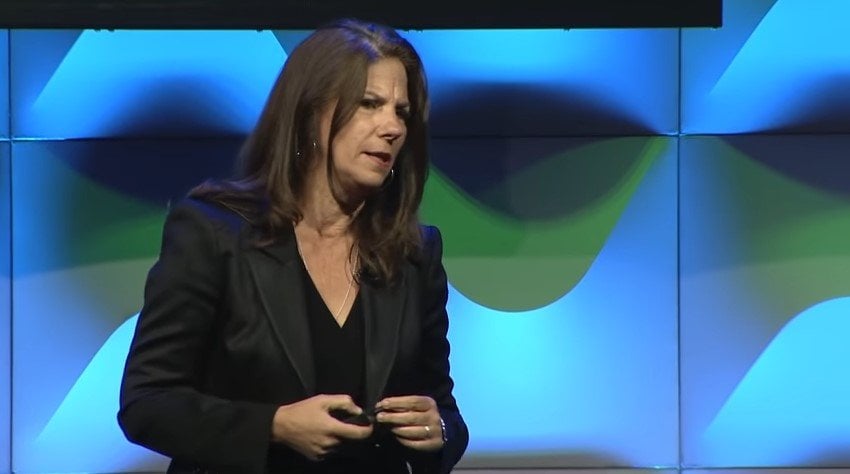“The difference between a great idea that gets adopted and a great idea that gets rejected is based solely on how someone communicates.” – Nancy Duarte, Author & CEO Duarte Inc, discusses Power Pitching to Investors at our KV Summit
Q2 hedge fund letters, conference, scoops etc
Nancy Duarte: Power Pitching To Investors
Transcript
I'm particularly excited to be here today. Today is my own firm's 30th anniversary. This year we're going to do. This year we'll do 30 million and I'm in a room talking to a bunch of 30 somethings that are going to shape the future not only of tech but of the world. I loved the intro that the node gave. That's going to give you guys the strength to pull all of that off. So my firm lives at this crazy intersection between business and storytelling and has done so for 30 years. Amazing brands. We've put the words in the mouths of some of the most powerful people on the planet. So I've personally seen the power of storytelling. I took a ten year journey through story to understand its power and why it is that it is so amazing. And that's because storytelling moves people. The structure of a story is that there's this really likable person. You who encounters these roadblocks the crazy messy middle and emerges changed. Being able to tell stories in a way that transforms and others is really powerful. Well now that we can hook MRI machines up to the brain we can tell what's really going on while a story is being told all the sensing parts of your brain are firing people feel when a story is being told. Also your brain aligns the storyteller and the story listener your brains are firing in the exact same order at the exact same time only when a story is being told. The other thing is it transports you.
They say that the analytical parts of the brain that causes doubt and conflict and make them not believe you. Those parts of the brain are suspended. They can transport and believe sometimes in the impossible. When a story is being told and the other thing that happened is when a group of people were told a story about a small child before they were asked to give money the ones that heard the story gave massively more generous to the ones who did not hear the story before they were asked to donate money. Stories will motivate you. They also have a structure that's actually kind of an analytical structure if you think about it just all the way back to Aristotle has a beginning a middle and an end. But yet when you apply that to your presentations so often we don't even do this simple three act structure of having a very clear beginning middle and end and you'll notice that between the beginning and the middle there's a turning point and between the middle and the end there's another turning point. Your talks need to have turning points to them too and I'll talk about that in a second. That was when I came across this shape which is afraid tags dramatic arc. He was a dramatist in Germany. He drew the shape in 1863. He said that stories had a five act structure which was the exposition of rising action of falling action and a denouement. I loved it because this demonstrates the rise and the fall. It was like breathing in and breathing out. There's this rising conflict and then that tension is released. And I thought wow there's something really beautiful about that.
And then when the folks at Cornell's computational story lab put all 6500 of Google's Gutenberg project stories into their database that confirmed that this arc is real. This kind of rise and fall and rise and fall. And I thought you know the greatest speeches that I've ever heard have a sense of a rise and a fall to them. It's a cadence and a rhythm and it draws you in and it releases you draws you in and releases and after going through a massive journey through storytelling including Joseph Campbell like a really really studied storytelling. I thought how do you use this tool to move others. How do you use it to accomplish great things. What do we need to do to infuse storytelling and all of her speeches. So I made this discovery I actually got a book called the 100 greatest speeches of all time. Went through this journey through storytelling and I just studied the patterns in the spoken word. When I overlaid storytelling over the greatest speeches a shape emerged. It's not an art. This would be equal to a story arc but this is a presentation arc. You could call it that. It has a beginning a middle and an end and it's the structure of a great talk. So the beginning should establish what is here's our shared reality. Here's our values here's what's going on. Here's the state of the Union. But this is what could be. And that gap between what is and what could be is like the inciting incident in a story. You're asking them to leave their current realities and join you on this journey into a better future.
And the middle goes back and forth between what is what could be what is what could be the human being can see and understand contrast we can see contrast and understand it this way if you stablished here's our current reality bit look we could be here. Suddenly what currently is isn't appealing and what could be is very alluring because they can see it. This last vertical line is your call to action.






